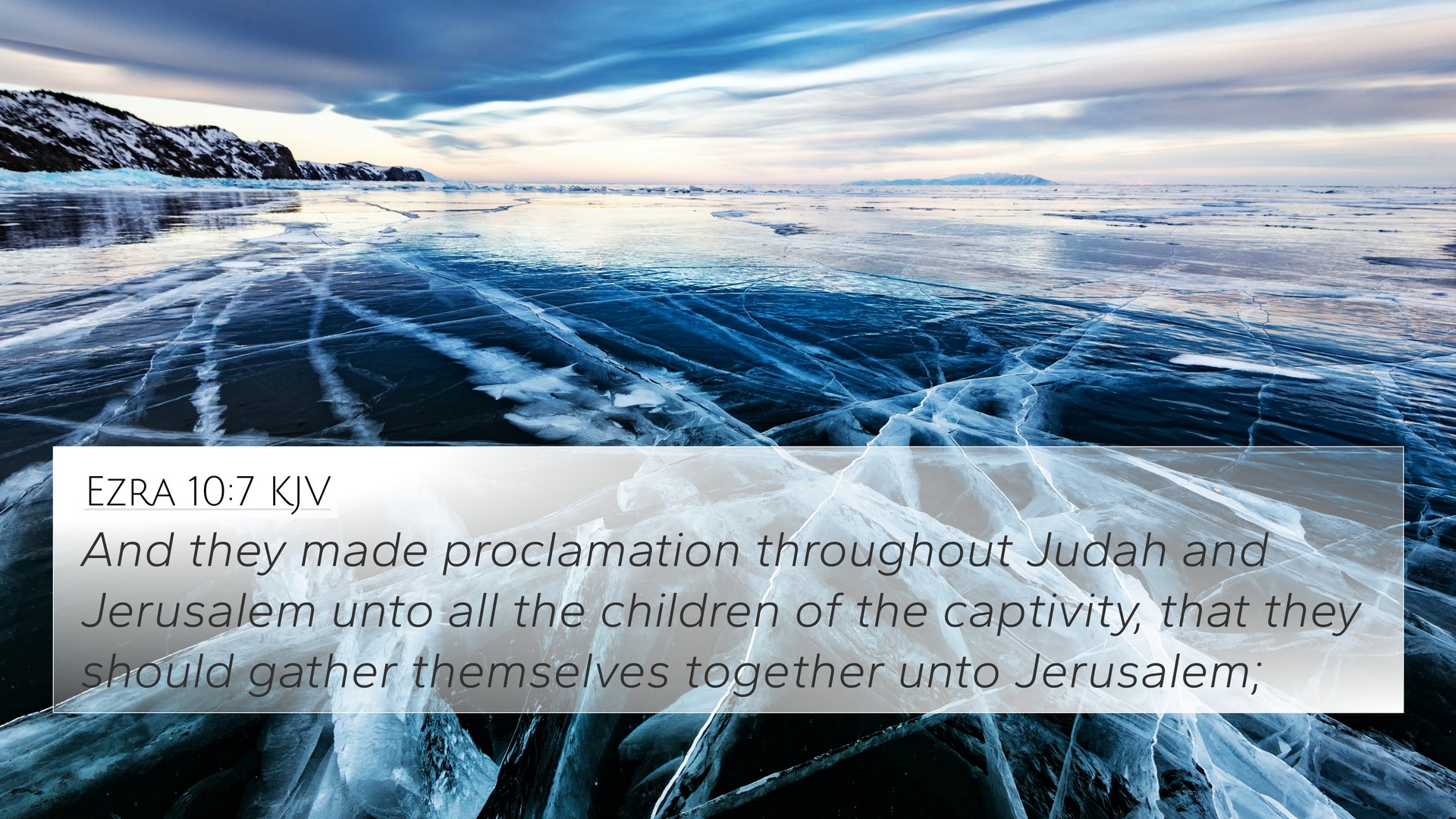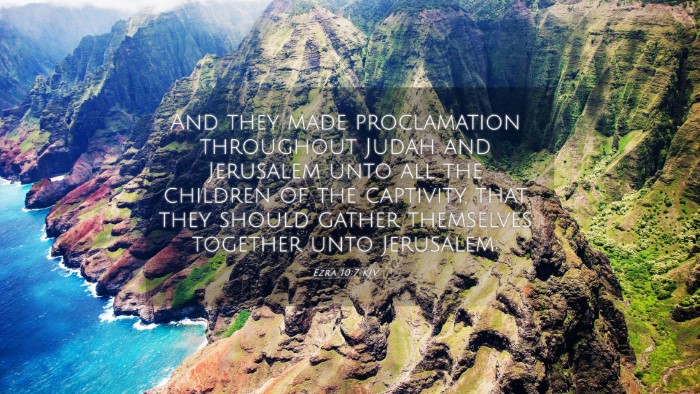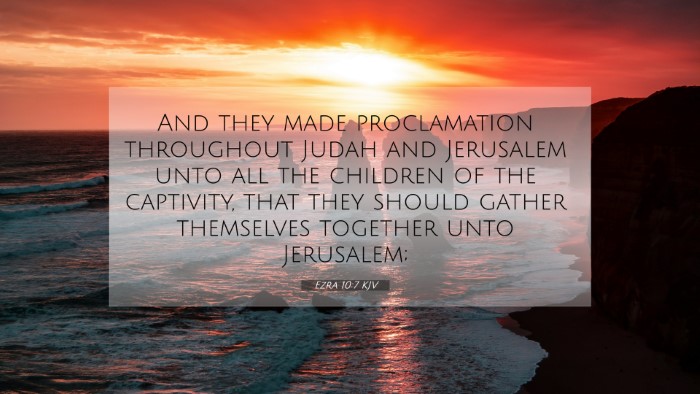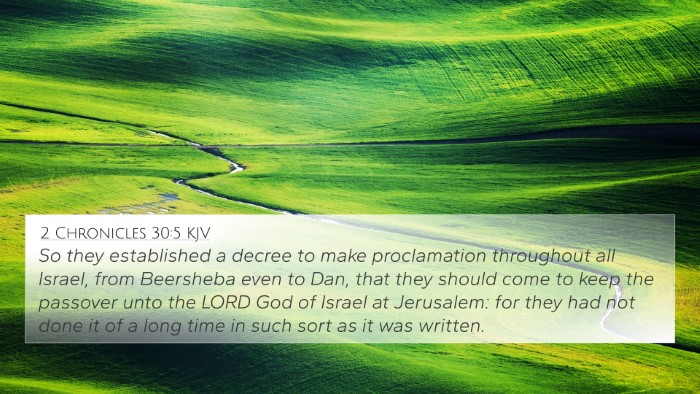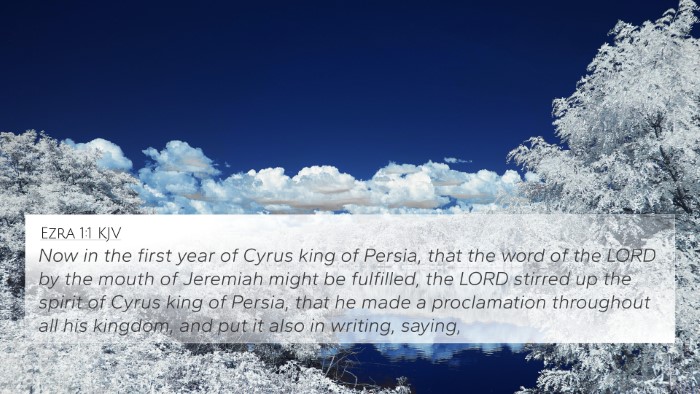Understanding Ezra 10:7
Ezra 10:7 reads: “And they made proclamation throughout Judah and Jerusalem unto all the children of the captivity, that they should gather themselves together unto Jerusalem.” This verse highlights the importance of communal involvement in addressing national and spiritual crises among the returned exiles. The proclamation serves as a call to collective action and repentance.
Commentary Insights
-
Matthew Henry:
Henry emphasizes the urgency of the call. The proclamation reflects the need for action to rectify the issues of intermarriage with foreign women, which was seen as a violation of the covenant. The gathering in Jerusalem illustrates a united front against sin and a commitment to restoring spiritual purity.
-
Albert Barnes:
Barnes notes that such public declarations were necessary for accountability and for the facilitation of corporate repentance. He suggests that the act of gathering signifies the acknowledgment of a collective identity among the exiles, which had implications for their religious and social obligations.
-
Adam Clarke:
Clarke elaborates on the motivations behind the proclamation, indicating that it not only aimed at remedying specific issues but also sought to re-establish the community's integrity. The call for gathering was essential for fostering cooperation and ensuring that all voices in the community were heard regarding the matter of intermarriage.
Related Bible Verse Cross-References
To deepen the understanding of Ezra 10:7, the following Bible verses relate thematically and contextually:
- Nehemiah 8:1: “And all the people gathered themselves together as one man into the street that was before the water gate…” - This reflects the unity and collective action of the people in spiritual matters.
- Malachi 2:11: “Judah hath dealt treacherously, and an abomination is committed in Israel and in Jerusalem…” - Highlights the seriousness of intermarriage, linking it to divine discontent.
- 1 Peter 2:9: “But ye are a chosen generation, a royal priesthood…” - Relates to the identity of the people as God’s chosen, emphasizing their responsibilities.
- 2 Chronicles 30:10: “So the posts went with the letters from the king and his princes throughout all Israel and Judah…” - Illustrates the act of gathering for a holy purpose.
- James 4:8: “Draw nigh to God and he will draw nigh to you…” - Speaks to the importance of coming together in repentance and commitment to God.
- Exodus 34:16: “And thou take of their daughters unto thy sons, and their daughters go a whoring after their gods...” - This Old Testament precursor warns against intermarriage and its consequences.
- Deuteronomy 7:3-4: “Neither shalt thou make marriages with them…” - Establishes the foundational covenantal laws regarding marriage.
Thematic Connections
Ezra 10:7 serves as a critical reflection on the themes of community, repentance, and the importance of maintaining spiritual integrity through collective action. It invites a greater exploration of how the community of believers is called to uphold God’s covenant through unity.
Using Bible Cross-References
Engaging with Bible cross-references can significantly enhance your understanding of Ezra 10:7 and the broader narrative surrounding it. Here are some tools and methods to effectively use cross-references:
- Bible Concordance: Utilize a Bible concordance to find relevant verses that discuss similar themes or topics.
- Bible Cross-Reference Guide: A cross-reference guide can connect you to parallel scriptures that enrich your study.
- Cross-reference Bible Study: Involve yourself in group studies that emphasize cross-referencing various scriptures for deeper insight.
- Bible Reference Resources: Explore commentaries and study Bibles that highlight cross-referenced verses alongside each passage.
- Comprehensive Bible Cross-reference Materials: Use tools that compile extensive cross-references, allowing for thematic study across the scriptures.
Conclusion
In summary, Ezra 10:7 is not just a call for the exiles to gather but a profound lesson on the significance of community and fidelity to God’s laws. By employing cross-referencing methodologies, one can uncover a rich tapestry of connections that reinforce the central themes of repentance, unity, and covenant fidelity found throughout the Bible.
